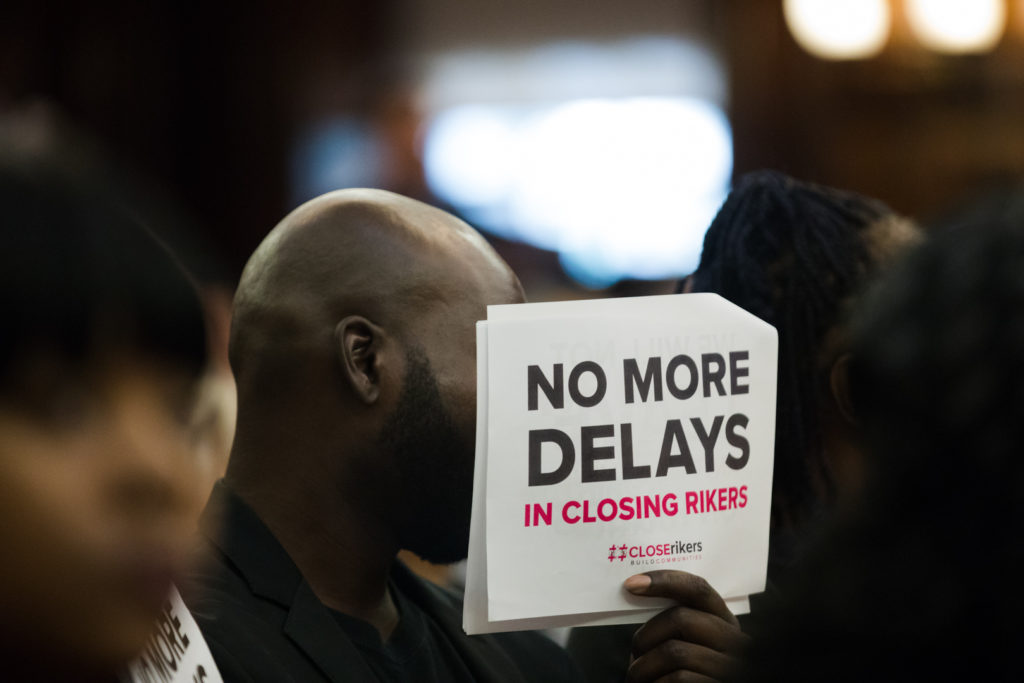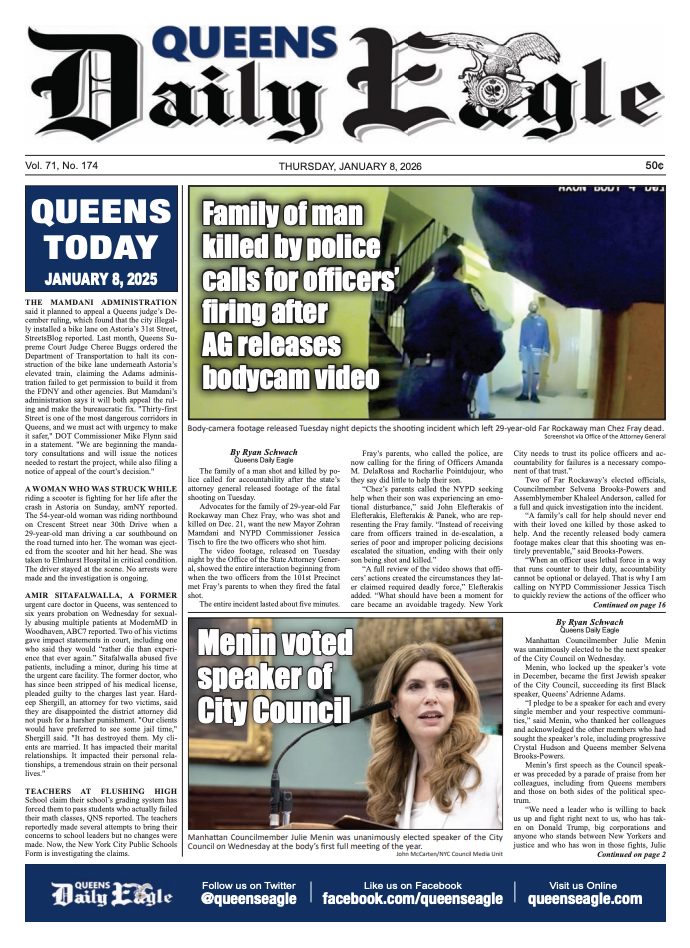The jail plan will likely pass. And the towers are getting smaller.
/The Rikers Island jail complex. AP Photo/Seth Wenig, File.
By David Brand and Noah Goldberg
Negotiations around the city’s initiative to build new jails in four boroughs have determined that all of the facilities will be smaller than currently proposed, though talks continue around the specific heights, sources close to the deal-making told the Eagle.
The plan to close Rikers Island by replacing the isolated jail complex with four new borough-based detention towers is heading toward a City Council vote next month — and it’s on its way to passing the 26-vote threshold necessary to set the plan in motion, according to City Hall and City Council sources.
A critical issue in rallying support for the plan is reducing the jails’ heights, which vary borough to borough. The Mayor’s Office has already conceded reductions, resulting in more council support, according to a source with knowledge of the negotiations.
“Council leadership, members and the administration have invested many hours working on a plan that the majority of the council could get behind,” a City Hall source told the Eagle. “Talks absolutely continue, but the fruitful efforts up to this point are leaving those involved feeling very good about the project.”
With just weeks left until the full-council vote on the unprecedented four-site land-use measure, the Brooklyn Eagle reached out to all 51 councilmembers to get their preliminary stances on Mayor Bill de Blasio’s plan.
Already, 18 councilmembers have told the Eagle that they plan on voting yes, or that they are leaning toward voting yes. Nine councilmembers said they are leaning toward or have decided on a “no” vote, while 16 said they remain undecided. The remaining 11 members of the council did not respond to repeated requests for comment.
Three former councilmembers told the Eagle that the jail plan will likely pass, though it may take some back-room deal-making. The former councilmembers requested anonymity so as to not alienate former colleagues.
“It’s going to happen. They’re going to posture and do things and maybe some will vote no,” said one. “It doesn’t get this far and not go through.”
“It will get done, but there will be a lot of tweaks,” said political consultant George Arzt. He believes a compromise between City Hall and the council on the height of the proposed facilities will enable councilmembers to save face with constituents opposed to the plan.
“The administration has enough of an opening with the reduced jail population to cut the height of the buildings, and I think that is the most significant factor in getting this done,” Arzt said. “That allows councilmembers to say, ‘They wanted X, but we did Y, and we got this done for our constituents.’”
Council Speaker Corey Johnson has not explicitly stated how he will vote on the final proposal, but he lent his support to the plan when it was announced last summer by the de Blasio administration. He also co-wrote an op-ed in April with former Chief Judge of the New York State Court of Appeals Jonathan Lippman outlining why he believes the borough-based jails land-use proposal — called ULURP — is essential to closing Rikers. In the op-ed, Johnson and Lippman list changes they would like to see, “such as finding non-jail, hospital-based alternatives for people with serious mental health diagnoses,” as well as investment in communities “hit hard by the inequities of the criminal justice system.”
The speaker’s support of the plan is pivotal when it comes to a full-council vote.
“The speaker is working closely with Councilmember Stephen Levin and the other affected members to work through many of the meaningful concerns that have been raised about the proposal. We need to close Rikers, how to do it is the question we’re trying to answer,” said Jennifer Fermino, a spokesperson for the speaker. Levin, who represents the area of Brooklyn where the planned jail site is located, supports the plan.
“I support the plan, but we still have a long list of issues we need to address,” Levin told the Eagle in a statement. One of the issues Levin prioritized is the size of the facility that will be located on Atlantic Avenue in Boerum Hill.
Mayor Bill de Blasio and New York City Council Speaker Corey Johnson shake hands on the 2020 budget, announced ahead of schedule on Friday. Photo by Ed Reed/Mayoral Photography Office.
The Mayor’s Office found new flexibility to negotiate on the size of the jails after criminal justice reforms passed in Albany this year — after the jail plan was made public. Bail, speedy trial and discovery reforms have slashed the projected size of the detained population from 5,000 to 4,000, making smaller buildings possible. A City Hall source told the Eagle that they now believe the detained population will be even further reduced.
The plan already has ample support in Manhattan, Brooklyn and Queens, with four, six and seven local councilmembers planning on voting in favor of the plan, respectively. The land-use proposal has no support yet in Staten Island, where two of the three councilmembers are Republicans — and where no jail will be built as part of the plan.
“Glad it’s not in Staten Island, but sucks for everybody else,” said a spokesperson for Staten Island Councilmember Joe Borelli, who did not say whether or not the councilmember will vote in favor or against of the plan.
A member of advocacy group Just Leadership USA at the City Council’s only public hearing on the borough-based jail plan. Eagle photo by Paul Frangipane.
In the Bronx, only Councilmember Diana Ayala — in whose district the Bronx facility would be located — has explicitly said she supported the city’s plan. Five other Bronx councilmembers said it was too early to decide or that they had significant issues with the plan, including the siting of the Bronx facility.
Despite a mention of “member deference” in Brooklyn — a controversial unwritten rule in the council that would have councilmembers vote in lock-step with the representative in whose district the land-use proposal falls — three of the 16 councilmembers in the borough have already come out against the plan.
The proposal has failed to garner support among more conservative Democrats who don’t believe that the jail complex at Rikers Island needs to be closed. It has also failed among some of the most left-leaning councilmembers who are concerned about spending large sums of money, like western Queens Councilmember Jimmy Van Bramer. The city estimates the plan would cost $8.7 billion.
“No one supports the plan. It’s crazy. Use half the money to rebuild on Rikers and half to fix homelessness and senior housing,” said Bronx Councilmember Ruben Diaz Sr., who does not support the plan.
“The main thing is I would like to know is where these jails are being built and what is being done to inform the local communities,” said Brooklyn Councilmember Alan Maisel, who said he is leaning toward opposing the plan.
The city has already selected the four sites for the facilities, including rebuilding and expanding the current Brooklyn Detention Complex in Boerum Hill, across the street from Brooklyn Criminal Court, and building a new facility on the site of the Queens Detention Center behind the Queens Criminal Courthouse in Kew Gardens.
“I don’t know why closing Rikers is a moral imperative,” Maisel also said.
But to most councilmembers, closing Rikers is certainly a moral imperative.
Queens Councilmembers Rory Lancman said he is willing to take a politically unpopular position on building a new jail because it means closing the violence-plagued, outdated Rikers Island facilities as soon as possible.
The plan “represents our best and only real hope to close Rikers Island in our lifetime and reform the criminal justice system here in New York City,” Lancman said. “We either close Rikers Island now through this plan, or our grandchildren will be talking about the evils of Rikers Island and wondering what to do about it.”
Councilmember Karen Koslowitz, who represents Kew Gardens — the site of the proposed Queens jail — has remained supportive of the plan, but said she would only vote yes if the city reduces the height from a proposed 270 feet.
Southeast Queens Councilmember Adrienne Adams, who chairs the land-use subcommittee that hosted last week’s public hearing, “is in favor of the borough-based jails with some modifications to the administration’s plan,” said a spokesperson. Adams want to reduce the size and scope of the proposal and ensure more programming is available for detainees, the spokesperson added.
Supportive councilmembers and lobbyists have expressed confidence that the plan will pass, and numerous sources within the council have told the Eagle they expect the land-use proposal to get at least the minimum of 26 votes. It remains to be seen what specific changes will be made to the proposal over the next month.






